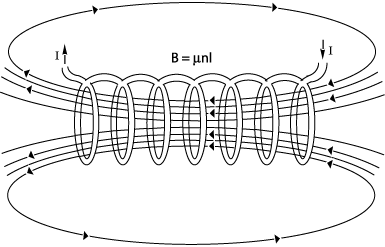|
|
|
|
| Solutions |
| Q1:
What should the the magnetic field for your solenoid look like? (Hint:
use right hand rule #2).
The magnetic field is concentrated into nearly uniform field in the center of a long solenoid. The field outside is weak and divergent.
Q2: Sketch, label and confirm the polarity of the B field using a small compass. Q3: Using the number of turns/meter (n) and assuming a current of 1.0 amps, what is the strength of the B field (in Teslas) in the center of your solenoid? B=(4px10-7Tm/A)(545.45n)(1.0A)=6.86x10-4T
Q4: How does this strength compare to the Earth's magnetic field? The Earth's magnetic field strength is 10-12 T, so the field strength of our solenoid is roughly eight orders of magnitude stronger. Q5: Can
you pick up paper clips or staples with your solenoid? Does
your solenoid deflect the compass needle? Q6: Replace the nail or bolt making the device an electromagnet. Now how many paper clips can you pickup? How well does the electromagnet deflect the compass needle? Compare with 3 -- the solenoid without the iron core. Q7: miron= 2000 mo. What does this mean about your electromagnet and how much stronger is the field strength and why? The strength is 2000 times greater because the iron core causes the current to be centrally located. Q8: Comment on how an electromagnet might be used. Identify a device that contains an electromagnet and discuss how the magnet is used. Electromagnets are used for many things such as; moving items, trains. MRI tests, etc. Another example is a doorbell, which uses an electromagnet in the form of a solenoid that pulls on a spring-loaded striker. When the doorbell button is pressed, the electromagnet is switched on, and the striker is pulled back. It strikes one bell, and then--as the person at the door releases the button--it strikes the other. (1--Ding! 2--Dong!) Try holding the button down and then releasing it slowly as you ring the doorbell next time and observe this effect. |
|
|
|
|
